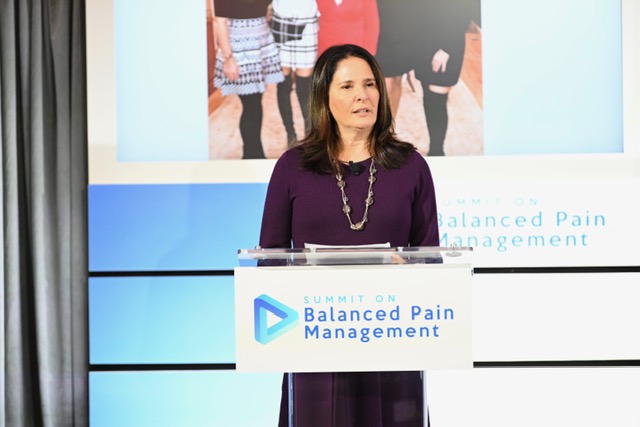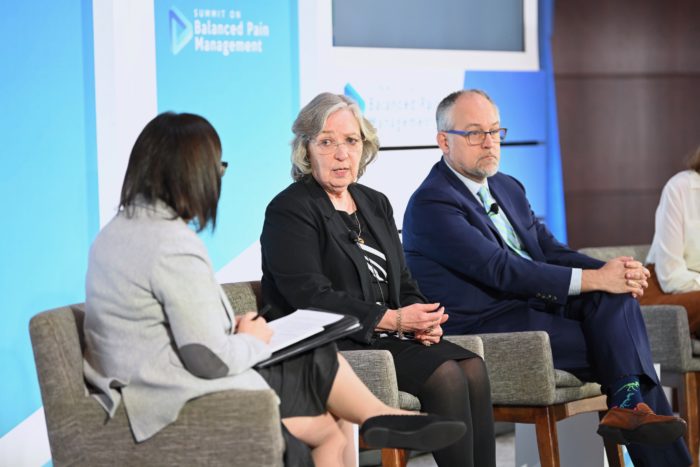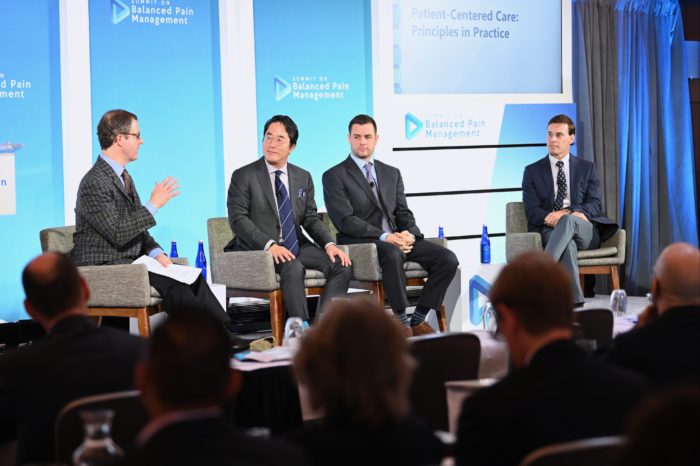Patient-Centered Care Dominates Pain Policy Summit
December 9, 2019
Pain is a single word with a thousand different meanings, as the sixth annual Summit on Balanced Pain Management made clear. So if policymakers want to tackle America’s pain problem, they should begin by embracing individualized, patient-centered, care.
What does that look like? Panelists and speakers at the day-long policy event in Washington, DC weighed in.
Profiles in Pain
For patients, it may begin with having their pain understood by family, society – and even their physicians. Through a series of “Profiles in Pain,” patients attested to how pain has shaped their lives. Shirley Kessel of Miles for Migraine described the intergenerational impact of migraine pain on her family. Kessel recalled her mother withdrawing from the family for days with migraine attacks, which now plague her and also prevent her two daughters from fulfilling their academic and professional potential.

For Penny Cowan of the American Chronic Pain Foundation, debilitating pain became manageable only after receiving interdisciplinary care at an inpatient facility. Cowan has since spent her life teaching others how to live with pain.
Pain also shaped the lives and careers of Dania Palanker, JD, of Georgetown Health Policy Institute and Kate Nicholson, JD, a civil rights attorney. Nicholson was an attorney enforcing the Americans with Disabilities Act when a surgical injury initiated intense back pain. She was forced to reconfigure her work through video conferencing and telecommuting.
Palanker, meanwhile, fought fibromyalgia pain throughout law school. She now dedicates her career to making insurance affordable and accessible to Americans from all walks of life. When it comes to coverage for alternative pain care and integrative techniques, “we have a long way to go,” Palanker emphasized.
Access & Innovation in Pain Care
Panel discussions reinforced Palanker’s concern.
Members of the Department of Health and Human Services’ Pain Management Best Practices Interagency Task Force have issued a “tour de force” report on policy solutions to America’s dual opioid and pain management crises, explained John Prunskis, MD, of the Illinois Pain Institute. Cindy Steinberg of the U.S. Pain Foundation conveyed the report’s conclusion that “Best practice is a multimodal, multidisciplinary approach” with both pharmacologic and non-pharmacologic treatments. But as Jianguo Cheng, MD, PhD, of the Cleveland Clinic explained, “If [multidisciplinary care is] not accessible, it’s meaningless.”

Continued innovation is also critical to making patient-centered pain care a reality. In a panel discussion hosted by Peter Pitts of the Center for Medicine in the Public Interest, the Food and Drug Administration’s Douglas Throckmorton, MD, explained how the agency is working to tackle the challenges presented by pain care. Leigh Callahan, PhD, of the Osteoarthritis Action Alliance emphasized the importance of clinical trials that gauge outcomes that matter to patients. Patients want to be able to “pick up their grandchild, play golf,” Callahan explained.
And Danielle Friend, PhD, of the trade group Biotechnology Innovation Organization noted that insurance coverage challenges can discourage innovation in new, opioid-alternative pain treatments. “It’s hard to get investment,” Friend noted, “if people think they won’t be reimbursed.”
Coverage challenges also arose during a panel discussion on access to patient-centered care. Matt Salo of the National Association of State Medicaid Directors noted that “there’s always a lag” between new approaches like integrative pain care and uptake. Salo emphasized the need for more data demonstrating that integrative and multimodal pain approaches work for patients. Ellen Blackwell, MSW, of the Centers for Medicare and Medicaid Services agreed, though she noted that some states have begun to “put their toes in the water” by providing coverage for alternative or non-pharmacologic treatments.

Ann Quinlan Colwell, PhD, RN, of the American Society for Pain Management Nursing emphasized the importance of a patient-centered approach, explaining that “each person feels pain differently and has a different ability to utilize different interventions and medications.”
Diverse Needs & Treatment Options
Addressing the different facets of pain often requires a multi-prong approach. In a panel discussion of integrative pain care, Mark Shepherd, PT, of Bellin College outlined the value of physical therapy. “We should empower our patients, we should educate them, and we should teach them to move in a way that’s comfortable,” Shepherd explained. Fellow panelist Greg Hobelmann, MD, of the Ashley Addiction Center noted the importance of emotional support and treatment for co-occurring psychological issues. And moderator Paul Christo, MD, of Sirius XM Radio’s “Aches and Gains” highlighted the power of neuromodulation for treating pain. Michael Leong, MD, of Stanford’s Pain Management Center agreed the technology could be “amazing,” especially for patients seeking non-opioid treatment options.

Meanwhile, a panel discussion of 2019 survey data underscored why patient-centered care is needed. Monica Mallampalli, PhD, of HealthyWomen reported that the organization’s study revealed a majority of women saying pain stopped them from living a full and active life. Brian Green of Health Union conveyed a key finding from a new study undertaken by Health Union and the U.S. Pain Foundation: patients in pain want a health care provider who uses a personalized, individualized approach and is willing to try alternative treatments. The patients’ primary goal, Green explained, is to maintain quality of life, keeping pain at manageable levels so people can go about their daily lives.

Josie Cooper of the Alliance for Gout Awareness conveyed study findings on how stigma and misinformation complicate treatment for gout, a painful form of arthritis. “Patients are self-treating and trying to do this on their own,” Cooper explained, “without consultation with a medical professional.”
The day-long event made it clear that education and access to patient-centered pain care are challenges that require committed advocacy from patients and health care providers. In closing remarks, Alliance for Patient Access National Chairman David Charles, MD, urged attendees to come together in the new year to advocate for policies that advance the approach.
The sixth annual Summit on Balanced Pain Management was convened by the Institute for Patient Access and hosted by the Alliance for Patient Access and the Alliance for Balanced Pain Management. See highlights and videos from the day’s event using #SummitBPM2019.
Categorized in: Blog

